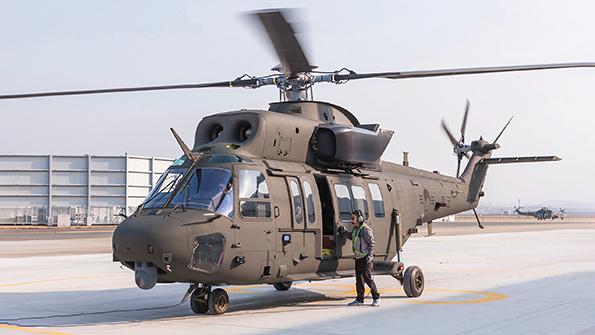
A transmission upgrade is expected to give the KUH-1 Surion the same lifting capacity as South Korea’s UH-60P helicopters.
South Korea’s aerospace industry mixes lofty ambitions with patient pragmatism. Instead of giant leaps, the industry prizes making advances in small steps toward a long-term goal.
So the launch last year of a high-speed rotorcraft by a national industry with little operational helicopter design history came as a surprise.
- KUH-1 upgrade to increase lift by 12.7%
- High-speed rotorcraft projects are in progress
Korea Aerospace Industries (KAI) has delivered more than 300 KUH-1 Surion helicopters to South Korean military and civil customers, but these are slightly modified, licensed versions of the Airbus AS352 Cougar.
Now KAI officials have revealed a key steppingstone on the path to an all-new design. The company’s rotary-wing division started working in March 2021 on a main gearbox upgrade for the KUH-1 fleet.
The new main gearbox would localize one of the most important technologies in rotary-wing aircraft. At the same time, the new design should increase the lifting power of the KUH-1, improving maximum gross takeoff weight by 12.7% to 22,000 lb. Such an upgrade would make the KUH-1 capable of lifting the same overall mass as South Korea’s Sikorsky UH-60Ps.
The upgrade is being developed using a familiar strategy for South Korea. Instead of spending heavily to create the intellectual property for the technology itself, the country seeks the assistance of foreign partners, leveraging offset agreements for military purchases of foreign weapon systems.
In this case, KAI has teamed up with Italy-based Avio Aero, a General Electric-owned company that produced the main gearbox for the original Airbus design and the KUH-1 derivative. Despite the assistance from Avio Aero, ownership of the intellectual property will reside in South Korea, KAI executives say.
The upgrade will increase the input/output speed-reduction ratio of the KUH-1 main gearbox by 25%, with the ratio rising to 5:1 from 4:1.
In parallel, South Korea’s industry is working on filling in the other major steps of a technology road map that could lead to a locally designed, high-speed rotorcraft.
During the Seoul International Aerospace and Defense Exhibition on Oct. 17-22, the Korea Research Institute for Defense Technology, Planning and Investment (KRIT) revealed several funded projects underway with South Korean companies to prepare for a high-speed rotorcraft that could replace the military’s fleet of UH-60Ps in the 2030s.
The projects include a variable-pitch pusher propeller for horizontal thrust, rigid coaxial main rotor system, fly-by-wire-based autopilot and low-drag airframe design that can incorporate stealth technology, according to posters on KRIT’s exhibit booth.

